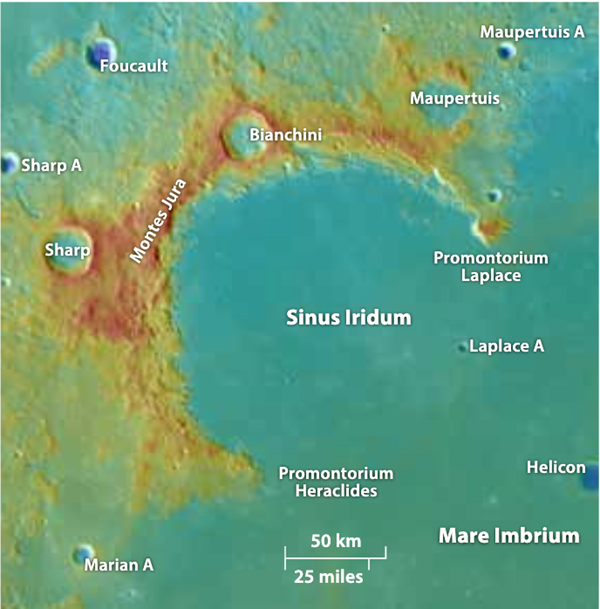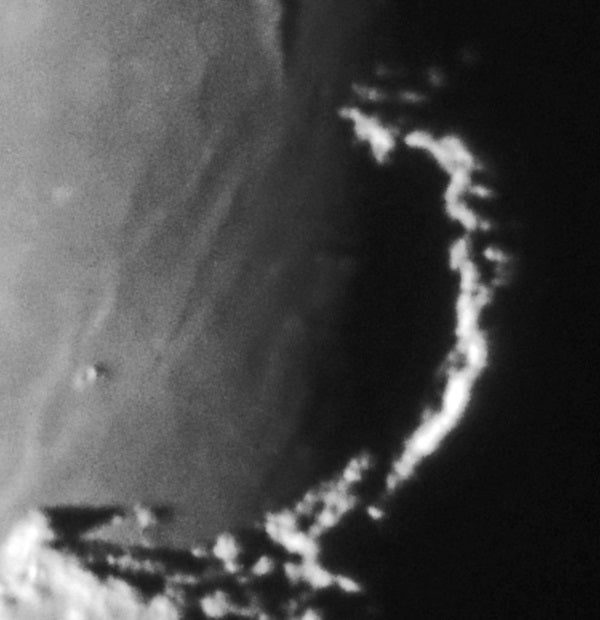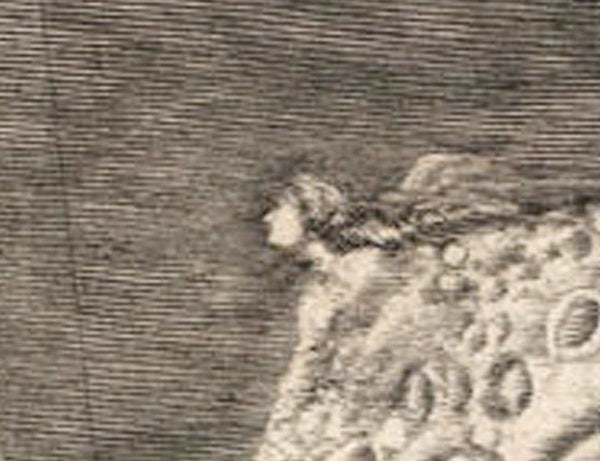The Moon never fails to surprise. This chiaroscuro world of ever-shifting shadows plays with our psyche. Wherever lies the terminator — the sharp dividing line between lunar day and night — so too do dramatic differences in darkness and light, casting some features into arresting highlights, while plunging others into an abyss of dark shadows. Sinus Iridum, the Bay of Rainbows, is one region where the low solar angle at the terminator can enhance surface texture, bringing out features that fill the sails of our imagination and activate memories that we can project onto the lunar landscape.
Part of the reason for the intrigue is Sinus Iridum’s complex geology and evolution. This 160-mile-wide (258 kilometers) lava plain lies on the northwest rim of Mare Imbrium (the Sea of Storms). It is the remains of a “small” impact event. Along its northwest rim, the ejecta formed the Jura Mountains, though the range we see today is undoubtedly only a portion of the original crater wall. The crater’s southeast rim was likely covered by episodic floods of basaltic lava from neighboring Mare Imbrium, which filled Sinus Iridum at least four times between 3.4 billion and 1.2 billion years ago.
Enter the imagination
Iridum’s seemingly soft, smooth floor and mountainous pastiche has been a playground for the imagination for centuries, inspiring observers and artists alike, including legendary American space artist Chesley Bonestell. Perhaps their early depictions of this region paved the way for my awe when I recently turned my 3-inch refractor to the Moon. The terminator shadow had just begun to lean into the Bay of Rainbows, and the smooth floor I expected to see was no more. In its place was rolling wave after rolling wave of light and shadow, rippling into the bay like a lunar tsunami.
The visual turmoil caused by this gentle interplay of bright and dark immediately transformed a cold and frozen landscape into a seemingly animated display of long waves. In ancient times, such a sight would have lent credence to beliefs that these dark regions of the Moon were vast bodies of water.
Adding to the aquatic scene was the haunting figure of a mermaid — a dramatic imagining created by the sunlit loops and shadowy folds of the Jura Mountains. This range ends in two capes: Promontorium Heraclides at the southwest tip and Promontorium Laplace at the northeast tip (which projects a slender shark-tooth shadow). Promontorium Heraclides is the mermaid’s head, complete with braided hair flowing to the west. The Jura Mountain’s sunlit northwest rim forms her torso, while an inverted V of jumbled terrain (near the crater Bianchini region) marks the mermaid’s flipper.
Seeing Promontorium Heraclides as a woman’s head is not surprising, given that it has long been known as the “Moon Maiden,” a depiction that first appeared on Giovanni Cassini 1679’s map of the Moon. The feature was intentionally rendered to appear like the profile of a woman’s head with wind-blown hair, looking out over the Bay like a widow on watch.
That I would see a larger figure among the intense light and shadow of the Jura Mountains is also not unprecedented. In his 1953 Guide to the Moon, the late British astronomy popularizer Patrick Moore wrote, “When the terminator passes close by, the mountain peaks of the eastern border (the Juras) catch the light, and the whole bay stands out from the blackness like a handle studded with gleaming jewels.” Ever since, that feature has been known as the Jeweled (or Golden) Handle Effect.
As for the waves in the Bay, these low sinuous ridges were most likely created by compressional and uplifting forces when deep, once-dormant faults reactivated. This caused surface layers to buckle along the crests of ridge-like rises — first the middle in inner bay, followed later by the outer bay. It is an example of visual artistry created by the invisible brush of global cooling on the Moon.
As always, send your observations and thoughts to sjomeara31@gmail.com.












